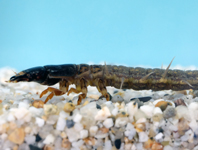Abstract
Rohrthripidae is a family of fossil thrips in the thysanopteran suborder Tubulifera. It includes a single genus, Rohrthrips, of which two species are previously known. Despite typical tubuliferan features, these thrips also show some terebrantian character states, particularly in the wings and antennae, and these are here interpreted as plesiomorphic. Five new species of these ancestral thrips are described from Burmese Cenomanian amber: Rohrthrips breviceps sp. n., Rohrthrips jiewenae sp. n., Rohrthrips maryae sp. n., Rohrthrips patrickmuelleri sp. n. and Rohrthrips schizovenatus sp. n.. Structures on the wings support the conclusion that the wings of Tubulifera are homologous with those of Terebrantia. Syninclusions in the amber fragments provide evidence of the diet and habitats of these ancestral thrips.
References
Bhatti, J.S. (1988) The orders Terebrantia and Tubulifera of the superorder Thysanoptera (Insecta). A critical appraisal. Zoology (Journal of Pure and Applied Zoology), 1, 167–240.
Bhatti, J.S. (1991) Surface patterns of wings in the order Tubulifera (Insecta). Zoology (Journal of Pure and Applied Zoology), 3, 1–95.
Bhatti, J.S. (1993) Phylogenetic relationships among Thysanoptera (Insecta) with particular reference to the families of the Order Tubulifera. Zoology (Journal of Pure and Applied Zoology), 4, 93–130.
Bhatti, J.S. (1994) Phylogenetic relationships among Thysanoptera (Insecta), with particular reference to the families of the Order Tubulifera. Zoology, 4, 93–130.
Bhatti, J.S. (1998a) New structural features in the Order Tubulifera (Insecta). 3. The tarsal hamus and thoracic appendages. Zoology (Journal of Pure and Applied Zoology), 5, 253–284.
Bhatti, J.S. (1998b) New structural features in the Order Tubulifera (Insecta). 4. The ovispan and other abdominal structures. Zoology (Journal of Pure and Applied Zoology), 5, 285–352.
Bhatti, J.S. (1998c) The New Technique of Light Microscopic Surface Scanning (LMSS) for Studying the Surface of the Transparent Cuticle of Small Insects. Oriental Insects, 32, 177–184.
https://doi.org/10.1080/00305316.1998.10433773
Bhatti, J.S. (2003) Some newly recognized characters of the Order Tubulifera representing highly conserved character states. Thysanoptera, Thrips No. 2, 41–48.
Cruickshank, R.D. & Ko, K. (2003) Geology of an amber locality in the Hukawng Valley, northern Myanmar. Journal of Asian Earth Sciences, 21, 441–455.
https://doi.org/10.1016/S1367-9120(02)00044-5
Ellington, C.P. (1980) Wing mechanics and take-off preparation of thrips (Thysanoptera). Journal of Experimental Biology, 85, 129–136.
Hörandl, E. & Stuessy, T. (2010) Paraphyletic groups as natural units of biological classification. Taxon, 59, 1641–1653.
https://doi.org/10.1002/tax.596001
Moritz, G. (2006) Thripse. In: Moritz, G. (Ed.), Pflanzensaftsaugende Insekten 1. Die Neue Brehm Bücherei. Bd. 663. Westarp Wissenschaften, Hohenwarsleben, pp. 1–384.
Mound, L.A. (2009) Thysanoptera. In: Resh, V.H. & Cadr, R.T. (Eds.), Encyclopedia of Insects. Elsevier Academic Press, Amsterdam, Boston, London, New York, Oxford, Paris, San Diego, San Francisco, Singapore, Sydney and Tokyo, pp. 999–1003.
https://doi.org/10.1016/B978-0-12-374144-8.00263-0
Mound, L.A., Heming, B.S. & Palmer, J.M. (1980) Phyllogenetic relationships between the families of recent Thysanoptera (Insecta). Zoological Journal of the Linnean Society, 69, 111–141.
https://doi.org/10.1111/j.1096-3642.1980.tb01934.x
Mound, L.A. & Marullo, R. (1996) The Thrips of Central and South America: An Introduction (Insecta: Thysanoptera). Memoirs on Entomology, International. Vol. 6. Associated Publishers, Gainesville, Florida, 487 pp.
Mound, L.A. & O'Neill, K. (1974) Taxonomy of the Merothripidae, with ecological and phylogenetic considerations (Thysanoptera). Journal of Natural History, 8, 481–509.
https://doi.org/10.1080/00222937400770411
Mound, L.A. & Palmer, J.M. (1983) The generic and tribal classification of spore-feeding Thysanoptera (Phlaeothripidae–Idolothripinae). Bulletin of the British Museum (Natural History), Entomology Series, 46 (1), 1–174.
Mound, L.A. & Walker, A.K. (1982) Terebrantia (Insecta: Thysanoptera). Fauna of New Zealand, 1, 1–113.
Nel, P., Peñalver, E., Azar, D., Hodebert, G. & Nel, A. (2010) Modern thrips families Thripidae and Phlaeothripidae in Early Cretaceous amber (Insecta: Thysanoptera). Annales de la Sociét entomologique de France, New Series, 46 (1–2), 154–163.
http://doi.org/10.1080/00379271.2010.10697651
Shi, G., Grimaldi, D.A., Harlow, G.E., Wang, J., Wang J., Yang, M., Lei, W., Li, Q. & Li, X. (2012) Age constraint on Burmese amber based on U–Pb dating of zircons. Cretaceous Research, 37, 155–163.
http://doi.org/10.1016/j.cretres.2012.03.014
ThripsWiki (2019) ThripsWiki—providing information on the world’s thrips. https://thrips.info/wiki/Main_Page (accessed 12 January 2019)
Ulitzka, M.R. (2015) Two new species of Aeolothripidae from Baltic Tertiary amber (Insecta: Thysanoptera). Palaeodiversity, 8, 89–94.
Ulitzka, M.R. (2017) Revision of the fossil Melanthripidae from Baltic Tertiary (Eocene) amber including a new genus (Insecta: Thysanoptera). Entomologische Zeitschrift, 127, 205–212.
Ulitzka, M.R. (2018a) A first survey of Cretaceous thrips from Burmese amber including the establishment of a new family of Tubulifera (Insecta: Thysanoptera). Zootaxa, 4486 (4), 548–558.
https://doi.org/10.11646/zootaxa.4486.4.8
Ulitzka, M.R. (2018b) Thrips-iD—Polygonothrips apertosetosus. Available from: http://www.thrips-id.com/en/2018/06/01/polygonothrips-apertosetosus/ (accessed 18 November 2018)

